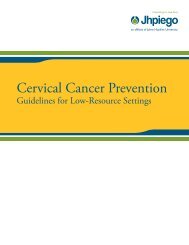Manual for Male Circumcision under Local Anaesthesia
Manual for Male Circumcision under Local Anaesthesia
Manual for Male Circumcision under Local Anaesthesia
Create successful ePaper yourself
Turn your PDF publications into a flip-book with our unique Google optimized e-Paper software.
<strong>Male</strong> circumcision <strong>under</strong> local anaesthesia<br />
Version 3.1 (Dec09)<br />
Sterilization can be done using:<br />
• high-pressure steam (autoclave) or dry heat (oven);<br />
• chemicals, such as ethylene oxide or <strong>for</strong>maldehyde;<br />
• radiation.<br />
Sterilization of all surgical instruments and supplies is crucial in<br />
preventing HIV transmission. All viruses, including HIV, are inactivated<br />
by high-pressure steam sterilization (autoclaving) <strong>for</strong> 20 minutes at<br />
121–132°C, or <strong>for</strong> 30 minutes if the instruments are in wrapped packs.<br />
Items that have been sterilized need to be properly stored, to ensure<br />
that they do not become recontaminated.<br />
• The storage area should be clean, dry, and free of dust and<br />
lint.<br />
• The temperature should be kept at approximately 24 °C, and<br />
the relative humidity at less than 70%, if possible.<br />
• Sterile packs and containers should be stored 20–25 cm off the<br />
floor, 45–50 cm from the ceiling and 15–20 cm from an outside<br />
wall.<br />
• Do not use wooden or cardboard boxes <strong>for</strong> storage of sterile<br />
items, as they shed dust and debris and may harbour insects.<br />
• Mark the date of sterilization on the package, and use the<br />
oldest packages first – “first in, first out”. Dates serve as an<br />
indicator of when packs should be used, but do not guarantee<br />
the sterility of the packs.<br />
Environmental cleaning<br />
Routine cleaning is important to ensure a clean and dust-free clinic<br />
environment. Visible dirt usually contains many microorganisms, and<br />
routine cleaning helps to eliminate such dirt. Administrative and office<br />
areas with no patient contact should be cleaned regularly in the same<br />
way as other offices. Most patient care areas should be cleaned by<br />
wet mopping; dry sweeping is not recommended. Hot water (80°C) is<br />
a useful and effective environmental cleaner. The use of a detergent<br />
solution improves the quality of cleaning.<br />
All horizontal surfaces and all toilet areas should be cleaned daily. The<br />
operating table and instrument trolley should be cleaned with<br />
detergent and water between cases.<br />
Management of spills<br />
Any area that is visibly contaminated with blood or body fluids should<br />
be cleaned immediately with detergent and water. After cleaning,<br />
disinfect the area with 0.5% sodium hypochlorite solution.<br />
Prevention of Infection Chapter 8-13
















